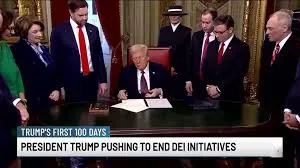
Trump Administration’s Ultimatum on DEI in Education
The Trump administration has issued a directive requiring U.S. educational institutions to eliminate Diversity, Equity, and Inclusion (DEI) programs within two weeks or risk losing federal funding. This mandate, outlined in a memo from the Department of Education, instructs schools and universities to cease practices that grant preferences based on race, affecting areas such as admissions, financial aid, and hiring. The administration argues that these DEI initiatives result in discrimination against white and Asian students, aiming to enforce a merit-based system. This directive builds upon Executive Order 14151, signed on January 20, 2025, which seeks to dismantle federal DEI programs and preferences.
The announcement has sparked significant concern among civil rights groups and educational organizations. Critics argue that eliminating DEI programs undermines efforts to promote diversity and address systemic inequalities in education. They fear that this move could have a chilling effect on initiatives designed to support marginalized communities, potentially leading to increased discrimination and a less inclusive educational environment.
This directive is part of a broader agenda by the Trump administration to curtail DEI efforts across various sectors. The Department of Government Efficiency (DOGE) and the Department of Education have warned state education departments that non-compliance with the order could result in the revocation of federal funding. This aggressive stance reflects the administration’s commitment to dismantling DEI programs, which they view as discriminatory and counterproductive.
Educational institutions now face the challenge of navigating this directive amidst widespread confusion and legal uncertainty. The potential impact on campus operations, admissions processes, and scholarship programs is profound, prompting institutions to reassess their policies to align with the new federal requirements. As the situation develops, schools and universities must carefully consider their approaches to diversity and inclusion within the constraints of the current legal and political landscape.